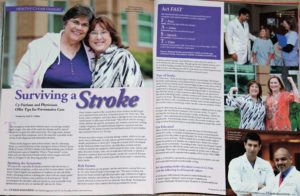 The Emergency Room doors whoosh open, welcoming a middle-aged couple. One side of the man’s face droops and his slurred words try to quiet his wife’s worst fears. The triage nurse, trained to recognize these symptoms, alerts the team that a possible stroke victim needs diagnosis and immediate attention.
The Emergency Room doors whoosh open, welcoming a middle-aged couple. One side of the man’s face droops and his slurred words try to quiet his wife’s worst fears. The triage nurse, trained to recognize these symptoms, alerts the team that a possible stroke victim needs diagnosis and immediate attention.
“When stroke happens, time is brain tissue,” says Dr. Mounang Desai, co-medical director of the emergency room at North Cypress Medical Center (NCMC). Stroke is the third-leading cause of death and foremost cause of disability. When a “brain attack” occurs, brain cells are deprived of blood, which carries oxygen and nutrients, so it begins to die. Reacting quickly is vital.
Spotting the Symptoms
“It’s important, especially for family members with risk factors, to know stroke’s symptoms, so they can act fast to assist others,” says Dr. Desai. Typical signals are numbness or weakness on one side of the body, a drooping smile or a drifting arm when both are raised, partial loss of vision or balance, and confusion or slurred speech. “Don’t second guess the situation, call your doctor ASAP if any dysfunction can be seen or visit the ER,” advises Dr. Desai.
Every minute counts in the crucial three-hour window needed to preserve optimum brain function. In laymen’s terms, Dr. Desai says, “The brain is like a computer, and when there is damage in one area, there are ramifications in other parts of the body.” When brain cells die during a stroke, abilities like speech, movement, and memory can be lost. Getting a proper diagnosis and rapid treatment improves a person’s outcome dramatically. “If a family member has risk factors, push for preventative care and know how to act,” he says.
Women may show unique symptoms during a stroke which occur suddenly: face or limb pain, hiccups, nausea, general weakness, shortness of breath, palpitations, or chest pain. Using the acronym FAST, developed by the National Stroke Association, can help those around a stroke victim to identify the symptoms. FAST stands for face, arms, speech, and time. If a smile droops, arms can’t be held above the head, or speech is slurred or confused, these can all signify a stroke has occurred. Because time is valuable, call 911 as soon as possible if you suspect someone has had a stroke.
Risk Factors
Strokes themselves are not genetic, but the risks factors causing them can be. Dr. Amy Nash of Modern Neurology says, “The most common risk factors for stroke include high blood pressure, high cholesterol or high triglycerides, diabetes and smoking. This is why it is very important to have a yearly physical so your doctor can check for these things. Keeping your risk factors under strict control is the best prevention for stroke.”
Diabetes, advancing age, atrial fibrillation, and a previous stroke or mini-stroke are also warnings. Though aging and a family history can’t be avoided, leading a healthy lifestyle that includes nutritious meals, daily activity and taking prescribed medications to control hypertension, cholesterol counts, and diabetes is within everyone’s reach.
Types of Stroke
Dr. Nash says, “There are two types of stroke: hemorrhagic, bleeding in the brain, and ischemic, a loss of blood flow to the brain due to a blocked artery or clot in a blood vessel.” Hemorrhagic stroke occurs when a blood vessel bursts. This can be caused by aneurysms, high blood pressure, and malformed or thinned vessels. A blood clotting disorder or medications that thin the blood, as well as trauma or illicit drug use, can also lead to this kind of bleeding stroke. Ischemic stroke results from a blocked blood vessel in the brain. This blockage can occur from a clot that travels from either the heart or the carotid arteries into the brain. Severe hardening of the arteries causes a narrowing which can also cause an ischemic stroke.
It’s key to determine the kind of stroke a patient is suffering from in order to begin safe and effective treatment. For ischemic stroke, the goal is clearing the clot from the blood vessel. Certain medications, called “clot busters,” when administered in the first three hours can aid recovery significantly. A hemorrhagic stroke receives the reverse treatment with drugs to lower blood pressure or surgical procedures to repair the vessel.
Get Educated
May is Stroke Awareness Month, so take the time to learn about and respond to stroke. A number of information sessions at area hospitals routinely invite the public to get educated. Dr. Nash will be participating in May’s events and says, “Both hospitals host excellent stroke support groups for patients and families on a regular basis. Stroke has a major impact in our community.” According to the Center for Disease Control, 795,000 people are affected by stroke each year in the U.S. and the effects are lasting. When signs of stroke go unnoticed, proper care is delayed. Prevention and quick response mean quality of life, so Act FAST. CFM
Act FAST
The National Stroke Association recommends this test to recognize and respond quickly to stroke symptoms:
F = Face Smile. Does one side of the face droop?
A = Arms Reach arms up. Does one drift downward?
S = Speech Say a phrase. Is speech slurred or confused?
T = Time Acting fast means quality of life.
If you observe any of these signs, call 911 or go to the nearest emergency department.
American Stroke Association stroke association.org
National Stroke Association stroke.org

